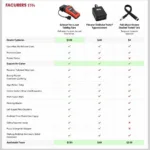A car power inverter for power tools can be a lifesaver on the job site, especially when you’re working remotely. These handy devices convert your vehicle’s DC power into AC power, allowing you to run a variety of power tools directly from your car battery. Choosing the right inverter and using it safely requires understanding a few key factors. This guide will delve into everything you need to know about car power inverters for power tools, from selecting the right wattage to safety precautions. We’ll cover the basics, help you find the perfect inverter for your needs, and ensure you use it safely and effectively. Let’s get started.
Understanding Car Power Inverters and Their Uses
Car power inverters essentially act as mini power stations, transforming the DC current from your car’s 12V battery into the AC current that most power tools require. This makes them incredibly useful in various situations, especially when access to traditional power outlets is limited. Think construction sites, remote locations, or even just quick roadside repairs.
Are you looking to learn how to run power tools off of car batteries? Check out our comprehensive guide. how to run power tools off of car batteries
Choosing the Right Wattage for Your Power Tools
The first step is determining the wattage requirements of your power tools. Each tool has a specific power draw, measured in watts. You’ll need an inverter with a continuous power output rating higher than the wattage of the most power-hungry tool you plan to use. Using an underpowered inverter can damage both the inverter and your tools. Look for the wattage information on the tool’s label or in its user manual.
Types of Car Power Inverters: Modified Sine Wave vs. Pure Sine Wave
There are two main types of car power inverters: modified sine wave and pure sine wave. Modified sine wave inverters are generally less expensive and suitable for powering simple tools like drills and saws. However, for sensitive electronics or tools with variable speed controls, a pure sine wave inverter is recommended as it produces cleaner power, mimicking the power from your home outlets.
Safety Precautions When Using Car Power Inverters for Power Tools
While incredibly useful, car power inverters require careful handling to ensure safety. Never operate an inverter in a wet or damp environment. Ensure your car’s engine is running when using power-hungry tools to avoid draining the battery. Also, be mindful of the inverter’s ventilation to prevent overheating.
Protecting Your Car Battery While Using Power Tools
Excessive power tool usage can drain your car battery, potentially leaving you stranded. Monitor your battery level regularly and avoid running the inverter for extended periods without the engine running. Investing in a battery monitor can help you keep track of your battery’s health. Want to learn more about electric car diagnostics? Visit our page on electric car diagnostic tools. electric car diagnostic tool
Choosing the Best Car Power Inverter: Key Features to Consider
When selecting a car power inverter, look for features like multiple outlets, USB ports for charging devices, and overload protection. A built-in cooling fan can prevent overheating, and a remote control can offer convenient operation. If you work with Volvo electric cars, you might be interested in our Volvo electric car diagnostic page. volvo electric car diagnostic
Understanding Inverter Efficiency and Power Loss
No inverter is 100% efficient. Some power is lost during the conversion process, typically around 10-20%. Choose an inverter with high efficiency to minimize power loss and maximize battery life. For information on general electrical car diagnostics, see our dedicated page. electrical car diagnostic
Conclusion: Empowering Your Work with Car Power Inverters
Car power inverters for power tools are invaluable tools for professionals and DIY enthusiasts alike. By understanding your power needs, choosing the right inverter type, and following safety precautions, you can effectively power your tools on the go and get the job done, wherever you are. Remember to always check the wattage requirements of your power tools and select an inverter that meets or exceeds those requirements for optimal performance and safety. Need help with hybrid car diagnostics? Check out our page. hybrid car diagnostic
FAQ
-
Can I run any power tool with a car power inverter? It depends on the wattage of the tool and the inverter. Always match the inverter’s continuous power output to the tool’s requirements.
-
What happens if I overload the inverter? Most inverters have built-in overload protection that will shut down the device to prevent damage.
-
How long can I run power tools off my car battery? It depends on the battery’s capacity, the tool’s power draw, and whether the engine is running. Running the engine is recommended for extended use.
-
What type of inverter is best for sensitive electronics? A pure sine wave inverter is best for sensitive electronics.
-
Do I need special cables to connect the inverter to my car battery? Most inverters come with the necessary cables. Ensure they are heavy-duty and properly connected.
-
What should I do if my inverter overheats? Turn it off immediately and allow it to cool down before using it again. Ensure adequate ventilation around the inverter.
-
Can I leave the inverter connected to the battery when the car is off? While some inverters have a low-power draw when idle, it’s generally recommended to disconnect it to prevent battery drain.
Need further assistance? Contact us via WhatsApp: +1(641)206-8880, Email: [email protected], or visit us at 910 Cedar Lane, Chicago, IL 60605, USA. Our 24/7 customer support team is ready to help.


